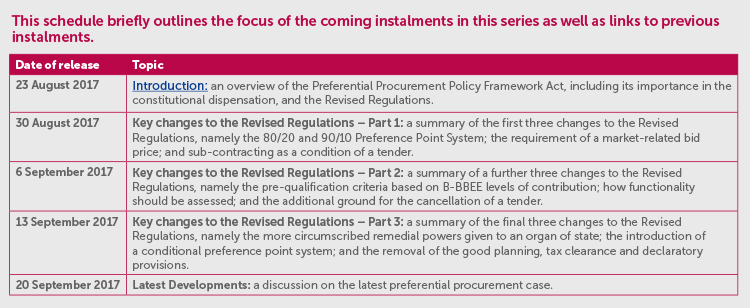Key Changes to Preferential Procurement Law: Part 1
Preference point system
One of the criteria used in adjudicating a tender is the preference point system. This provides that tenders be evaluated out of a score of 100 points, with a maximum of 20 or 10 points being allocated to preference (more specifically, the B-BBEE level of an entity) and the remaining 80 or 90 points (as the case may be) being allocated to the most competitive price tendered.
The 2011 Preferential Procurement Regulations (2011 Regulations) stipulated that the 80/20 preference point system applied to tenders worth up to R1 million, while the 90/10 preference point system applied to tenders with a rand value above R1 million. The value includes all applicable taxes.
The Revised Regulations change this monetary threshold by providing that the 80/20 preference point system applies to tenders with a rand value equal to or above R30,000, with a maximum rand value of R50 million, while the 90/10 preference point system applies to tenders worth more than R50 million.
The impact of this change is that the 80/20 preference point system will now apply to tenders with a maximum value of R50 million, which is the majority of tenders. Prior to the Revised Regulations, businesses could neglect to focus on B-BBEE levels disregarding the loss of the 10 points awarded therefor, instead relying on being awarded the complete 90 points for offering goods and services at the most affordable price. However, with greater weight being given to a tenderer’s B-BBEE level when awarding the tender, this will compel businesses to transform meaningfully in order to remain competitive during the tender process.
Requirement of a market-related bid
The introduction of the requirement of a market-related bid means that the organ of state may not award a contract to a tenderer where the price offered by the tenderer is not market related. Where this is the case, the organ of state may negotiate a market-related price with the tenderer scoring the highest points (thereafter with the tenderer with the second highest points, and then third highest points) or it may elect to cancel the tender. If a market-related price is not agreed with the tenderer scoring the third highest points, the tender must be cancelled.
Notably, the Revised Regulations do not define what is meant by a “market-related” bid. However, the Implementation Guide published by National Treasury instructs officials to conduct an industry and commodity analysis to ascertain market-related prices and rely on their discretion to benchmark bids received.
This requirement of a market-related bid is directly linked to the constitutional injunction contained in s217(1) of the Constitution, in particular, that of cost effectiveness.
Sub-contracting as a tender condition
The Revised Regulations, unlike the 2011 Regulations, state in peremptory terms that where feasible, organs of state are mandated to require that tenderers sub-contract a minimum of 30% of the rand value of any contract worth more than R30 million. Regulation 9(2) provides that a tenderer must sub-contract to:
“(a) an [exempted micro enterprise (EME)] or [qualifying small business enterprise (QSE)];
(b) an EME or QSE which is at least 51% owned by black people;
(c) an EME or QSE which is at least 51% owned by black people who are youth;
(d) an EME or QSE which is at least 51% owned by black people who are women;
(e) an EME or QSE which is at least 51% owned by black people with disabilities;
(f) an EME or QSE which is 51% owned by black people living in rural or underdeveloped areas or townships;
(g) a cooperative which is at least 51% owned by black people;
(h) an EME or QSE which is at least 51% owned by black people who are military veterans; or
(i) more than one of the categories referred to in paragraphs (a) to (h).”
Importantly, an organ of state must provide a list of all the registered suppliers, with the approval of National Treasury, who fall within the applicable designated groups from which the tenderer must select.
The sub-contracting requirement acknowledges that most tenders with a rand value equal to or above R30 million are awarded to established companies. Therefore, the Revised Regulations require all businesses with the ability to deliver goods and services to sub-contract to designated groups.
In the next alert we will discuss the next three significant changes occasioned by the Revised Regulations.

The information and material published on this website is provided for general purposes only and does not constitute legal advice. We make every effort to ensure that the content is updated regularly and to offer the most current and accurate information. Please consult one of our lawyers on any specific legal problem or matter. We accept no responsibility for any loss or damage, whether direct or consequential, which may arise from reliance on the information contained in these pages. Please refer to our full terms and conditions. Copyright © 2026 Cliffe Dekker Hofmeyr. All rights reserved. For permission to reproduce an article or publication, please contact us cliffedekkerhofmeyr@cdhlegal.com.
Subscribe
We support our clients’ strategic and operational needs by offering innovative, integrated and high quality thought leadership. To stay up to date on the latest legal developments that may potentially impact your business, subscribe to our alerts, seminar and webinar invitations.
Subscribe



